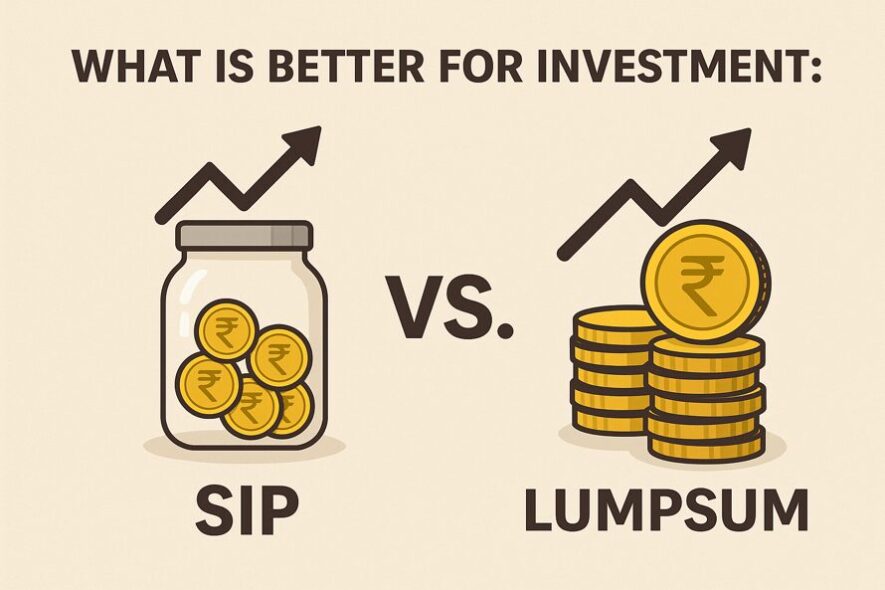
Introduction to Investment Modes
Every investor faces this dilemma: Do I invest everything in one shot, or do I spread it across months? It’s the classic battle of Systematic Investment Plans (SIPs) versus lumpsum investing. Both promise growth. Both can build wealth. Yet the way they play out in real life feels very different.
One gives you discipline, the other gives you a head start. One cushions volatility, while the other thrives when timing is right. To understand SIP vs. lumpsum, you need to know how each works, when they shine, and how they behave in different markets.
What is SIP (Systematic Investment Plan)?
Think of SIP as the “installment plan” for your investments. Instead of throwing in one big cheque, you drip-feed smaller amounts every month. It’s like setting up a standing order that builds your wealth quietly while you get on with life.
How SIP Works
Here’s how it plays out. You pick a mutual fund, decide the amount, ₹5,000, ₹10,000, whatever fits your pocket, and every month, that amount gets auto-debited. Each contribution buys units at the market price (NAV) of that day.
Markets high? You get fewer units. Markets low? You scoop up more. Over time, this dance of buying at different levels balances out. That’s the power of rupee cost averaging working in the background.
Benefits of SIPs (Rupee Cost Averaging, Discipline)
Two words define SIP: averaging and discipline. Averaging means you don’t need to lose sleep over timing. You keep investing, and the ups and downs smooth out.
Discipline is the second win. SIP locks you into a routine. Just like a gym membership pushes you to show up, SIP makes sure you invest month after month. Salaried folks love it because it syncs perfectly with payday cycles.
Ideal Use Cases for SIP Investments
Who should lean on SIPs? Anyone who wants to start small, stay consistent, and ride out volatility. Young professionals, families saving for kids’ education, or even first-time investors who want to test the waters, SIPs fit them all. They shine in choppy markets where nobody can really call the top or bottom.
What is lumpsum investment?
Now flip the coin. Lumpsum is the “all in” approach. You’ve got a big chunk of money, maybe from a bonus, inheritance, or property sale, and you deploy it in one go. Instead of spreading across time, you put it to work immediately.
How Lumpsum Works
Simple mechanics. You invest ₹5 lakh today in a mutual fund. From that very day, the entire sum participates in the market. If markets rise, your capital compounds faster because it’s fully exposed. If markets tumble, you feel the full impact, at least on paper. There’s no averaging to soften the blow.
Benefits of Lumpsum (Compounding, Early Advantage)
The magic of lumpsum is compounding with a head start. More money invested earlier means more years of growth. Time in the market beats timing the market if your horizon is long enough.
It’s also hassle-free. One transaction, and your money is working. For investors who dislike the discipline of monthly deductions, lumpsum feels faster and more efficient.
When to Choose Lumpsum Investing
Lumpsum scores when valuations look attractive or when you’re parking long-term money. Retirees investing their retirement corpus, or someone receiving a windfall, often prefer it. The caveat? You need the stomach to handle volatility, because all your money is in the arena from day one.
SIP vs Lumpsum: Key Differences
Both approaches help grow wealth, but they respond differently to markets and investor needs.
Investment Timing and Market Volatility
SIPs protect you from bad timing. By spreading entries, they average out the cost and soften volatility. Lumpsum bets heavily on your entry point. If you catch a bull run, it feels like magic. If you hit a downturn, it feels like bad luck.
Capital Commitment and Liquidity
SIPs commit small, regular amounts, leaving you liquid for other needs. Lumpsum ties up large capital instantly. If you think you’ll need money soon, SIPs are safer. If liquidity isn’t an issue, lumpsum can maximize compounding.
Return Potential and Risk Tolerance
Lumpsum carries higher risk and higher immediate return potential. SIPs trade some return for smoother rides. It’s a matter of personality, risk-takers prefer lumpsum, cautious investors lean on SIP.
Factors to Consider Before Choosing Between SIP and Lumpsum
The decision is less about products and more about your life’s philosophy.
Income Stability and Cash Flow
If you earn a salary, SIP aligns naturally. It matches cash inflow. Business owners or people with irregular income often find lumpsum more practical when surplus comes in.
Market Conditions at Entry Point
Volatile markets? SIPs give protection. Clear bull run or undervaluation? Lumpsum capitalizes better. Timing matters here, but so does comfort level.
Investment Goals and Time Horizon
For short-term goals, neither SIP nor lumpsum in equities is ideal. For long-term wealth, both work. SIP builds gradually; lumpsum accelerates early compounding. Match the style to your investment horizon.
Performance Comparison: SIP vs Lumpsum in Real Scenarios
Numbers tell the story best. Let’s see how both play out under different market conditions.
Bull Market Example
In a roaring bull market, lumpsum dominates. All your money rides the uptrend from the start. SIP enters gradually and helps you build gains over a period.
Bear Market Example
Here, SIP steals the show. By investing steadily during a market downturn, you continue to buy at lower NAVs. When markets recover, your average cost is much lower. A lumpsum invested before the fall takes longer to break even.
Long-Term Market Average Case
Stretch the investment horizon to 15–20 years, and the gap narrows. SIPs and lumpsum often converge because time and compounding smooth out volatility. What matters more is that you stay invested.
Tax Implications for SIP and Lumpsum Investments
Both SIP and lumpsum fall under the same tax rules, but the way they’re calculated differs slightly.
Capital Gains Tax Treatment
Capital gains from equity mutual funds are taxed as short-term capital gains (STCG) if they are sold on or before the completion of one year. The tax rate applicable is 20% plus cess.
Long-term capital gains (LTCG) apply if you sell your mutual fund holdings after the completion of one year. The tax rate applicable is 12.5%.
For debt mutual funds, purchase dates are key to determining taxation. Generally speaking, investments made on or after April 1, 2023, are taxed as short-term capital gains at your slab rate. For investments made before this date, LTCG at the rate of 12.5% applies after a holding period of two years.
Tax Efficiency Based on Holding Period
SIP creates multiple purchase dates, so each installment has its own clock for tax calculation. Lumpsum has one date, making tax tracking easier. Over long horizons, the efficiency gap closes.
Which is Better: SIP or Lumpsum? Expert Verdict
There’s no single winner here. SIPs build habits, reduce timing risk, and suit regular earners. Lumpsum maximizes compounding when you’ve got capital ready and a long runway. Experts often recommend blending both, steady SIPs plus opportunistic lumpsum investments when you have a surplus amount to invest.
Conclusion
When debating SIP vs. Lumpsum, the answer lies less in the product and more in the person. SIPs suit salaried individuals who value consistency and protection from timing mistakes. Lumpsum suits investors with surplus capital and the confidence to ride market swings.
At the end of the day, wealth grows through patience and discipline. Whether you drip-feed through SIP or dive in with lumpsum, the key is to stay invested, let compounding work its magic, and align choices with your financial life.
FAQs:
Q. Is SIP always better than lumpsum?
Not always. SIP works well in volatile or uncertain markets, while lumpsum can outperform in strong bull runs. The “better” choice depends on timing, risk appetite, and available capital.
Q. Can I do both SIP and lumpsum in the same fund?
Yes. Many investors start with a lumpsum to deploy surplus and then continue with SIPs for regular contributions. This way, money works immediately while discipline builds over time.
Q. How does market timing affect lumpsum returns?
Lumpsum is highly sensitive to entry points. Investing at a market peak slows growth, while entering at undervalued levels accelerates compounding. Timing makes a bigger difference in lumpsum than in SIP.
Q. What is the best time to start a SIP?
There is no single best time to start an SIP. SIPs thrive on consistency and compounding, so the sooner you start, the more time your money has to grow.
Q. How much should I invest via SIP?
It depends on your income, expenses, and goals. A common thumb rule is to invest at least 20–30% of monthly income, but the actual amount should align with your long-term targets.
Q. Are SIP returns guaranteed?
No. SIP returns depend on the performance of the chosen fund and market conditions. The advantage of SIP is reduced timing risk, not guaranteed returns.




